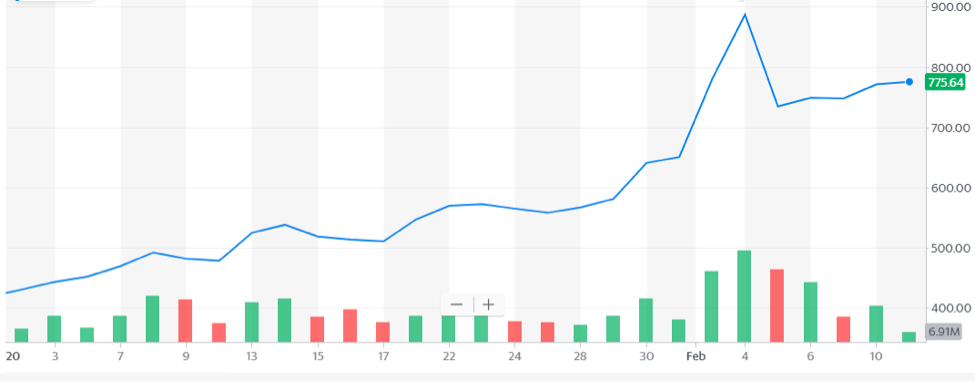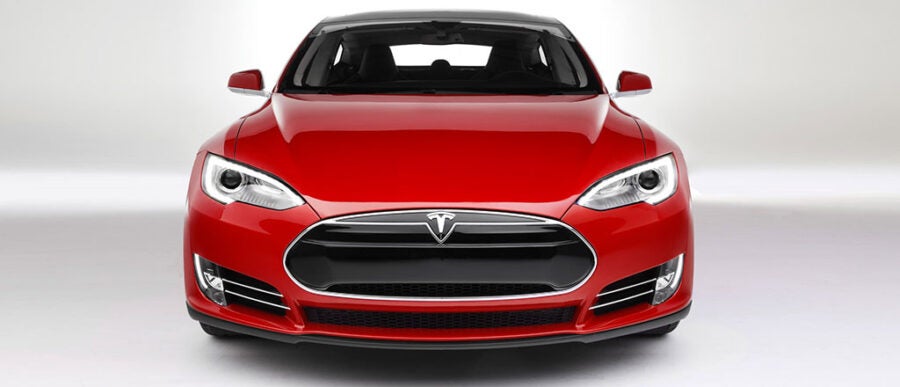Tesla, the electric vehicle company based in Palo Alto, Calif., has recently witnessed dramatic volatility in its stock price. The company’s market capitalization recently crossed $140 billion, 75% more than General Motors and Ford combined. On the morning of February 13, Tesla announced a $2 billion stock offering and the stock actually went up almost 5% on the day (a very unusual reaction when a company sells stock and dilutes existing shareholders).
But what is Tesla really worth? The answer depends on several factors, writes David Erickson in this opinion piece. He is a senior fellow in finance at Wharton and co-teaches a course on Strategic Equity Finance. Before teaching at Wharton, Erickson worked on Wall Street for more than 20 years, helping private and public companies raise equity strategically.
On the first three trading days of February, Tesla’s stock went up approximately $130 a share, then it went up another $100 a share … and then down more than $150 a share. While for a stock index such dollar changes are not unusual, for a stock whose company is worth more than $100 billion in equity value, this kind of extreme volatility is unprecedented. So, what happened … and now what?
A few theories could help explain what is going on:
- A Massive “Short Squeeze”: According to the Wall Street Journal, losses for short sellers since January exceeded more than $8.4 billion and more than $2.4 billion last week alone. Over the last several years, Tesla has consistently been one of the most shorted stocks in the U.S. markets (and in early February, the biggest short interest of any U.S. stock). Interestingly, Tesla CEO Elon Musk has always taken a relatively aggressive approach with these “short sellers.”
- “FOMO” (Fear of Missing Out) After Better Than Expected Q4 Numbers: Tesla reported in late January better Q4 numbers than Wall Street expected. This from a company that over the last few years set high expectations and often failed to deliver. The other piece to the FOMO theory is that Q4 was also the second profitable quarter in a row. This means that with four quarters of profitability, Tesla would be eligible to be included in the S&P 500, the largest equity index and one of the most followed indices globally. With the median market cap of the companies in the S&P 500 approximating $55.6 billion, Tesla would be a significant addition by investors that benchmark against the S&P 500.
- Quantitative–driven Funds Got Involved: With the extreme volatility and volumes that Tesla’s stock exhibited the first week in February, it “hit the screens” of many of the quantitative funds, causing more active trading of Tesla to take place. This caused Tesla’s stock to trade so much volume (~148 million shares) in the first three days of February that it equaled what it normally trades in 15 trading days.
- Buying Power from ESG Investors: With Blackrock, the world’s largest asset manager, highlighting in the CEO’s annual letter in mid-January their focus on ESG (environmental, sustainable and governance) investing going forward, this obviously generated more enthusiasm for companies like Tesla, which are regarded as meeting ESG criteria. This, along with the size of the ESG investing market now exceeding more than $30 trillion gives long-term support to ESG investable companies.
- Tesla Bulls Got More Vocal: On the back of Tesla’s strong Q4 numbers, several analysts raised their opinions and price targets. Tesla’s most-bullish analyst at a smaller firm, ARK Invest, raised her price target to $7,000 a share (from $6,000) by 2024. In addition, before the market opened on February 4, a long-time Tesla bull (and one of its largest shareholders), Ron Baron, founder and CEO of Baron Capital, forecasted on CNBC that Tesla would reach $100 billion in revenues in four years (Tesla reported $24.6 billion in 2019) and could do $1 trillion in revenues by 2030. Now, the ARK analyst has been super bullish for a while and this isn’t a new forecast by Baron. Still, with Tesla surprising the market with better-than-expected numbers, these positive voices provided more support to a stock already poised to go higher.
While the movements in Tesla’s stock price are the result of some combination of these factors, some explanations sound far-fetched. One of them is that investors have been buying the stock in anticipation of Tesla being included in the S&P 500. The potential inclusion is at least two quarters away, and Tesla still also needs to be included. In other words, one of the S&P 500 companies has to be removed from the index, through M&A or another event, for a company to be added.
The theory about the power of ESG investors is also unconvincing. Some $30 trillion or so managed for ESG investments isn’t new money; it was there before last week. While you could make the argument of FOMO by some of these investors, you could make a similar argument for many growth investors. Moreover, according to Yahoo Finance, Tesla’s ESG risk score (as measured by Sustainanalytics’ ESG Risk Ratings), only puts Tesla in the 59th percentile, which means the stock probably wouldn’t be top of mind for ESG investors on its ESG qualifications alone.
YTD Tesla Stock Price Chart

What’s Next?
With Tesla shares having gone up more than 85% YTD and almost 150% in the last year, the stock has had a significant re-valuation. However, some key questions still remain. Among them:
- Is Tesla management stable? In the last few years, Tesla has seen a number of senior people leave. While Elon Musk is a great visionary, he also needs a strong team to help Tesla continue to execute. Additionally, Musk has had some issues in recent years including problems with the S.E.C. and on a few occasions not demonstrating the best judgment. While investor concerns about Musk seem to have subsided with the rising Tesla stock price, expectations going forward have also risen.
- What will Tesla’s competitive environment be and is its “first mover” advantage enough? While Tesla has established significant share in the electric car market globally, there are lots of potential competitors like BMW, GM and Toyota (to name a few). The Tesla “bears” seem to think that these well-established competitors in traditional vehicles are a major market share threat to Tesla because they will cut costs to build share. On the other end, the Tesla “bulls” believe that Tesla has established a significant first-mover advantage and has built a pretty good “moat” (including more efficient manufacturing and distribution than the major vehicle makers). Is Tesla the “Apple of 2001” when it changed the game with the introduction of the IPod (and now the IPhone) and continues to evolve and grow share; or Netflix, which pioneered content streaming, but now faces a significant threat as it builds content, while well-funded competitors with lots of content like Disney are getting more aggressive.
- With U.S. tax credits expiring and potentially at risk in China, how will this impact demand? With the U.S. having phased out tax credit subsidies for Tesla cars at the end of 2019, the question on some investors’ minds was whether the robust Q4 performance was influenced by increased demand before the phase out; and if so, if it would have material impact on lowering demand in 2020. Additionally, questions about the continuation of China’s tax credits (already sliced in half last summer), with the serious impact of the trade war and now the horrible coronavirus (and its potential costs) on its economy, could also impact demand in China, Tesla’s expected biggest market going forward.
- What will be the capex spend going forward? While Tesla generated positive free cash flow for 2019 after severely ratcheting down its capex spend to $1.3 billion (vs. $2.1 billion in 2018 and Tesla’s original guidance of $2 billion to $2.5 billion for 2019), questions remain with all the new product lines (cybertrucks, semis, etc.). What will be Tesla’s capex going forward? And how will that impact cash generation in the next few years?
- Does Tesla need more capital? This doesn’t seem as obvious after the equity deal that they just announced. However, is $2 billion really enough for a company that just went cash flow positive for its first fiscal year (by ratcheting back capex); has very aggressive expansion plans (both in new product lines and more manufacturing capacity); and has been very close to “running on fumes” in recent years? The current stock price, in combination with the volatility embedded in Tesla’s stock, provides much more potential financing flexibility than Tesla has ever had in the past. Given Tesla’s considerable use of convertible bonds in the past, they could also easily get some relatively cheap debt-like financing done. One adage we use in our Strategic Equity Finance course is companies should “raise money when you can; not when you have to.” Unfortunately, “when you have to” can often be more expensive (and with more onerous terms); and in some very challenging cases, financing may not be available at all.
- How much is Tesla worth in terms of valuation? With Tesla’s stock currently trading at 33x Enterprise Value/2021E EBITDA, it is trading at significant premium to the so-called FANG stocks (Facebook, Amazon, Netflix, Google), with the exception of Netflix, which is trading at similar multiple levels and has similar expected EBITDA growth rates but has significantly higher expected margins than Tesla does.
Can Tesla’s stock continue to “electrify” the market? Its shareholders hope so. Especially Musk, with his current stake and the billions of dollars’ worth of options he negotiated in 2018, hopes to keep dancing the “electric shuffle” (as he did from Tesla’s Shanghai plant a month ago that he posted on Twitter).



